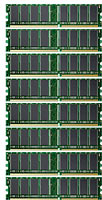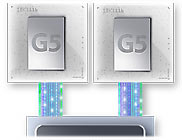Forged from a long-standing partnership between two companies committed to innovation, the G5 drives the largest performance gain in the history of the PowerPC. The 64-bit G5 speeds up to 2GHz and can address 8GB main memory.
 Shatters the 4GB ceiling
Shatters the 4GB ceiling
32-bit PCs can only use 4GB of memory. Any more than that requires the use of virtual memory on the hard drive, which is 40 times slower than using RAM. The new Power Mac G5 can offer up to 8GB of RAM thanks to the 64-bit G5. So you can store entire 3D worlds, huge scientific data sets and oversized 2D images all in main memory, which lets you manipulate them faster. To repeat: 40 times faster. Theoretically, the 64-bit data paths let the Power PC G5 access up to 4 terabytes of physical memory. Impractical now, maybe, but the Power PC G5 architecture allows for plenty of growth well into the future.
 Magic bus
Magic bus
And to get at that data, the PowerPC G5 features an industry-leading 1GHz frontside bus for each processor, offering a staggering 16 GBps throughput on dual PowerPC G5 systems. That’s a huge leap over today’s Power Mac G4, with a bus speed of 167MHz. That means you won’t have a bottleneck getting information to the chip for processing.
Award-winning logic
The PowerPC G5 gets its smarts from the execution core of IBM’s 64-bit POWER4 processor — recipient of the Microprocessor Report’s 2001 Analyst’s Choice Award for Best Workstation/Server Processor. The POWER4 drives IBM’s successful eBusiness servers, with highly parallel processing, two double-precision floating-point units and advanced branch prediction logic. Apple collaborated with IBM to leverage this industry-leading design for the G5, combining an optimized Velocity Engine with a new superscalar, superpipelined execution core that supports more than 200 simultaneous in-flight instructions. But you won’t have to buy new software to take advantage of the Power Mac G5 speed boost, because Apple and IBM designed the PowerPC architecture to scale from 32- to 64-bit from the beginning. |
|



